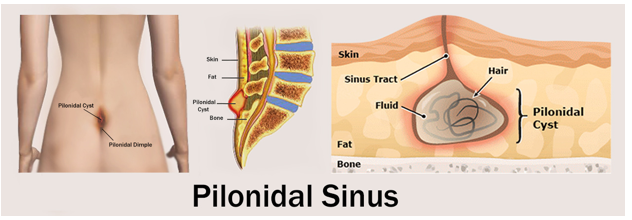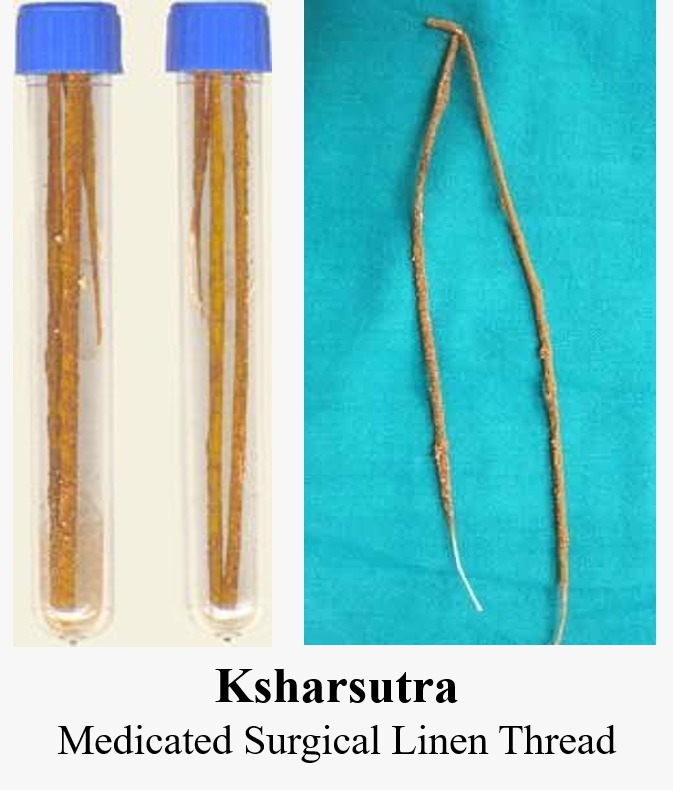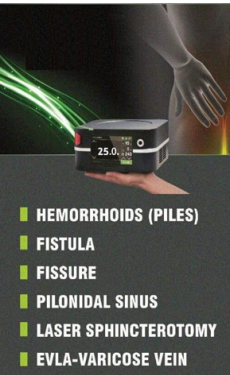What is Pilonidal Sinus?

A Pilonidal sinus also called Pilonidal cyst, Pilonidal abscess or Sacrococcygeal fistula is a cyst (small sac) or tunnel in the skin. It develops over the tailbone at the top of the cleft of the buttocks. The cyst usually contains hair and skin debris. More than one cyst may develop, and these are linked by tunnels under the skin. It can cause severe pain and can often become infected, in which case, it may ooze pus and blood and have a foul odor.
Causes of Pilonidal Sinus
- More common in males
- Sedentary lifestyle
- People who sit for long hours at a stretch eg. Drivers
- Thick body hair especially those that are coarse and curly
- Obesity
- Previous injury in the area
- Family history of Pilonidal Sinus
- Having a deep cleft between buttocks
- History of previous Pilonidal Cyst
Symptoms of Pilonidal Sinus
- Recurring episodes of pain or swelling in the area of the tailbone.
- Pain when sitting or standing
- Swelling of the cyst
- Redde
- ned, sore skin around the area
- Pus or blood draining from the abscess, causing a foul odor
- Hair protruding from the lesion
- Formation of more than one sinus tract, or holes in the skin
Treatment of Pilonidal Sinus
Although the Pilonidal Cyst / Abscess / Sinus are not a life-threatening disease, it is one of the most difficult to be completely cured because the modern classical medicine finds it difficult to give a definitive treatment. Here is why:
- The antibiotics and anti-inflammatory formulations do not particularly affect the coccyx cyst.
- Draining the fluid from the cyst does not mean immunity from infection in the ulcer. The ulcer that is created does not heal easily because of the location and texture.
- Fistulas created in the region are also very difficult in healing.
- A surgical resection of this kind has risks of failure or relapse.
- Patients who have surgery unless they have symptoms postoperative pain, slow healing and prolonged edema also require much recovery time with the patient lying prone (face down) position.
1. Conservative Treatment
If your case is diagnosed early on, you aren’t experiencing severe pain, and there’s no sign of inflammation, it’s likely that your doctor will prescribe a broad-spectrum antibiotic, which is an antibiotic that treats a wide range of bacteria. It’s important to realize that this won’t heal the sinus tract, but it will give you relief from the infection and discomfort. Your doctor will recommend that you get a follow-up exam, regularly remove hair or shave the site, and pay particular attention to hygiene.
2. Lancing
Before this procedure, your doctor will give you a local Anesthecia. They will then use a scalpel to open the abscess. They will clean away any hair, blood, and pus from inside the abscess.
Your doctor will pack the wound with sterile dressing and allow it to heal from the inside out. The wound usually heals within four weeks, and many patients don’t require any further treatment.
3. Ksharsutra Treatment For Pilonidal Sinus
In case of more bleeding and severe pain with single Pilonidal Sinus, we recommend Ksharsutra Treatment. Our proctologist, Dr. Sachin Pandhare have more than 10 years of experience treating Pilonidal Sinus and healed thousands of patients successfully.

Ksharsutra is first prepared by coating a surgical linen thread gauge number 20 with Snuhi latex (Euphorbia nerifolia) for 11 times. Snuhi latex and Apamarga Kshara for 7 times and Snuhi latex and Haridra churna for 3 times.
On visual inspections, once the location of the pilonidal sinus is confirmed, the patient must be with local or spinal or general anesthesia while treatment. First, hairs and unhealthy granulation tissue will be removed through the opening on skin. Then a malleable probe must be passed through sinus tract and traced until it’s blind end and another opening is made over the skin up to the tip of the probe. In final step, probe is removed through another opening after feeding of ksharsutra and ligated appropriately. ksharsutra is changed every week. This helps effective curettage and drainage facilitates healing without recurrence.
Benefits of Ksharsutra
- No hospital stays
- Routine works unaffected
- Minimal pain
- Usually performed under local anesthesia
- No tissue loss, no ulcer or wound
- No foul smell, wound dressing
- Effective results
- No dressing required
- Widely accepted and Clinically proven
- Recurrence rate is low
Ksharasutra treatment is advantageous to the patients with pilonidal sinus, which is also a non-excisional treatment.
4. Pilonidal Sinus Surgery
If you have a recurring Pilonidal Sinus or if you have more than one sinus tract, our Proctologist will recommend a surgical procedure. You will first be given an anesthesia. Then, the surgeon will open the lesions, removing all of the pus and debris. Once this process is complete, the surgeon will stitch the wounds closed. After surgery, your doctor will explain how to change the dressings and will recommend shaving the site to prevent hair from growing into the wound.
Wide excision and healing by secondary intention.
This operation involves cutting out (excision of) the sinus but also cutting out a wide margin of skin which surrounds the sinus. The wound is not closed but just left open to heal by natural healing processes (healing by ‘secondary intention’). This usually requires several weeks of regular dressing changes until it heals fully. The advantage of this method is that all inflamed tissue is removed and the chance of the condition coming back (a recurrence) is low.
Excision and primary closure.
This means taking out the section of skin which contains the sinus. This is done by cutting out an oval-shaped (ellipse) flap of skin either side of the sinus, which takes out the sinus. The two sides of the ellipse are then stitched together. The advantage for this is, if successful, the wound heals quite quickly. The risk of a recurrence or of developing a wound infection after the operation is higher than with the above procedure. This risk may be reduced by using a wound technique in which the line of stitches is moved away from between the buttocks.
A plastic surgery technique.
In some cases, where the sinus recurs or is extensive, plastic surgery may be advised to remove the sinus and refashion the nearby skin.
There are variations on the above procedures, depending on your circumstances, the size and extent of the sinus, and whether it is a first or recurrent problem.
5. Laser Treatment for Pilonidal Sinus

Traditional surgery involves rather unusually large and deep round wound that takes several months to heal.
Laser treatment is literally a non-invasive, completely painless. The method involves no additional incision or wounds more than enlarging slightly the existing opening, then a radially emitting Fistula Laser Fiber is inserted from the enlarged opening till end point of sinus. A defined amount of laser energy is then emitted circumferentially into the sinus tract. The laser energy causes controlled photothermal destruction of the sinus tract causing it to collapse to a high degree. This also helps supports and accelerates the healing process. This painless laser procedure is done under anesthesia. This laser treatment is contraindicated in pilonidal cyst and abscess formation. Laser treatment is effective in tunnel or sinus formation.
“We are the referral center of many surgeons and physicians for KsharSutra and Laser Treatment of Pilonidal Sinus.”
After your treatment, the nurse will go over few instructions and you will be given a prescription for few medications and an appointment for a postoperative checkup few days later.

